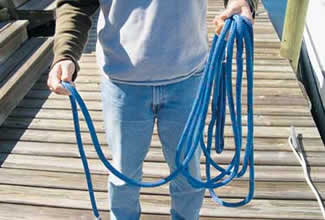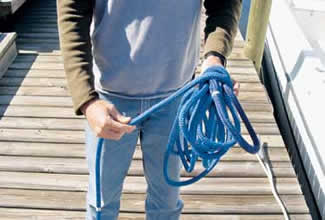May 11, 2016
By Frank Sargeant
Keep your dock lines shipshape.
Most anglers are fairly casual about their seamanship, and that's understandable. The boat is mostly a tool to get you to the fish, so you may not be all that concerned with the traditions and the niceties of the marlinspike.

Organized and ready for action.
|
But there are practical reasons for learning a few of the basic old-saltisms, not the least of which is that you just might someday save your boat—to say nothing of your backside—because you did things right.
Handling ropes aboard—seamen call them “lines”—is one of those skills that a lot of us never get around to learning. Look in the box of just about any center console or flats boat and you'll find an absolute snakes-nest of tangled dock lines, bow lines and anchor rode.
While storing ropes that way is easy when you put them in, it's hard when you take them out. And if you need that dock line in a hurry, as when you're about to be pushed into another boat by a booming current and a strong wind working together, you'll wish you had taken the time to put your lines away in an orderly fashion. This is also a good way to store extra anchor line for those trips out to the shelf—it's tough untangling a hundred feet of extra line when you're bouncing up and down in 4-footers.
The classic storage for most lines aboard is called a “
gasket coil,” and you do it thusly:

Coil clockwise, just less than arm's length.
|
Start by coiling the rope; hold one end in your left hand and bring the coils to it with your right. (If you're coiling heavy rope or lots of it, you may have to do the coiling on deck rather than between your hands, but the rest of the steps are the same.) By tradition, lines on boats are always coiled clockwise; that way, everybody knows how to unwind any coil they may have to use on any boat.
The coils should be a little less than an arm's length in diameter for easy handling. Sometimes, putting just a bit of clockwise twist into three-strand twisted rope with your right thumb and fingers will help the coils lie “fair” or flat. If the line wants to twist, you can work a bit of the twisting out by pinching the line with your left fingers and thumb as you coil.

For the "gasket coil," wrap the end three times around coils, counter-clockwise.
|
When you're down to the last arm's length, take three complete turns around the upper part of the coil, this time wrapping counter-clockwise. Now make a bight or loop in the last 18 inches of line, and tuck that through the eye of the coil above the three turns.
Bring this bight back down over the top of the entire coil. Now pull gently on the loose end and snug the bight against the wraps. You wind up with the coil secured all around, and you can hang up the line by the loose end, or you can store it below decks.

Next, form a loop and run it throught the open coils.
|
To put the line back into service, you can loosen the tie and pull the bight back over the top of the coil, unwrap the wraps and you're ready to go in seconds.
If you're just hanging up a line between docking points, you can go with a simpler coil; coil the line as before, but this time take only one counterclockwise turn around the coils. Now pass a bight through the eye of the coil above the turn. Last step is to run the bitter end of the line through the bight, thus cinching it against the coil and creating a handle to hang up the line. This one doesn't work so well for storing in a hatch; it tends to come apart if the coil is not hung up, but otherwise it's a useful thing to know.
Braided lines, often used as dock lines, don't have significant twist in them and often form a figure 8 when coiled. This is not a problem; they can still be secured as above. So long as all the “8s” lay the same way, the line won't tangle and will run free when you need it.

Bring loop over the top of the coils, snug, and gasket coil is complete.
|
A few final tips: though the coils described here allow you to proudly hang your lines out for all to see, it's a good idea to stow them out of the sun if your boat is not going to be used for several weeks. UV rays cause nylon to become weak and brittle over the years, so you'll extend the life of your lines by stowing them in the shade. It's also not a bad idea to give your lines a bath every now and then; a cup of bleach per gallon of fresh water, plus a few drops of dish soap, will get out salt and stains. Some add a dash of fabric softener to the bucket to make the lines more flexible and easier on the hands. Dry the lines before stowing to prevent mildew.
Hang your coiled lines where you can access them quickly while you're on the water. It's best to stow them for long periods out of the sunlight, however.
Having your lines untangled and ready as you approach the dock is easy if you coil your lines properly after each use.
FS
